BUICK CENTURY 1994 Owners Manual
Manufacturer: BUICK, Model Year: 1994, Model line: CENTURY, Model: BUICK CENTURY 1994Pages: 308, PDF Size: 16.3 MB
Page 161 of 308
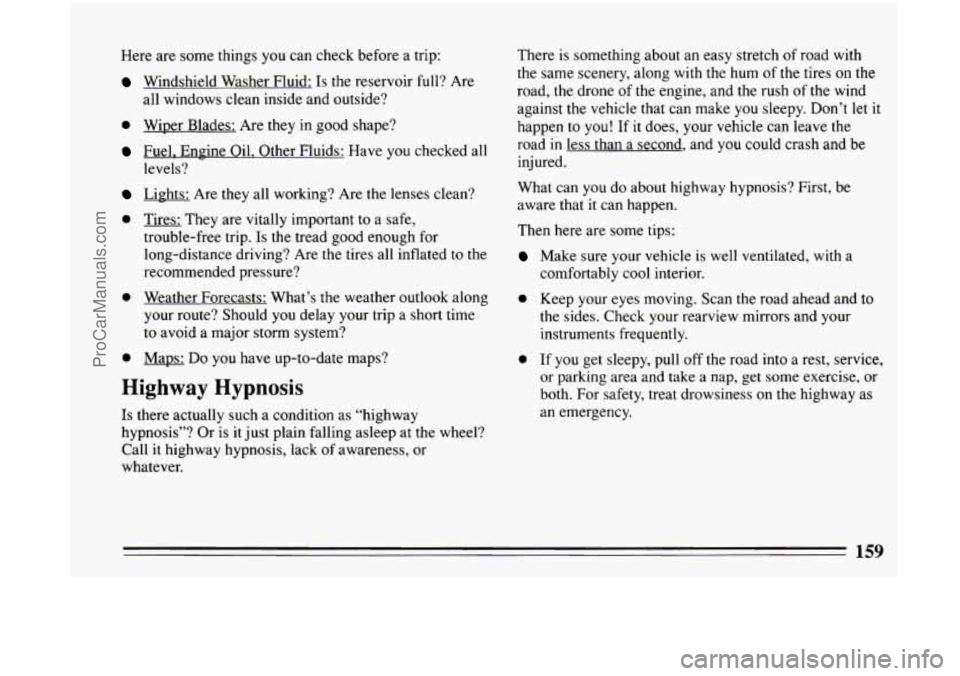
Here are some things you can check before a trip:
Windshield Washer Fluid: Is the reservoir full? Are
all windows clean inside and outside?
0 Wiper Blades: Are they in good shape?
Fuel. Engine Oil. Other Fluids: Have you checked all
levels?
Lights: Are they all working? Are the lenses clean?
0 Tires: They are vitally important to a safe,
trouble-free trip.
Is the tread good enough for
long-distance driving? Are the tires all inflated to the
recommended pressure?
0 Weather Forecasts: What’s the weather outlook along
your route? Should you delay your trip a short time
to avoid
a major storm system?
0 Maps: Do you have up-to-date maps?
Highway Hypnosis
Is there actually such a condition as “highway
hypnosis”? Or is it
just plain falling asleep at the wheel?
Call it highway hypnosis, lack of awareness,
or
whatever. There
is something
about an easy stretch of road with
the same scenery, along with the hum of the tires on the
road, the drone of the engine, and the rush of the wind
against the vehicle that can make you sleepy. Don’t let it
happen to
you! If it does, your vehicle can leave the
road
in less than a second, and you could crash and be
injured.
What can you
do about highway hypnosis? First, be
aware that it can happen.
Then here are some tips:
Make sure your vehicle is well ventilated, with a
comfortably cool interior.
0 Keep your eyes moving. Scan the road ahead and to
the sides. Check your rearview mirrors and your
instruments frequently.
0 If you get sleepy, pull off the road into a rest, service,
or parking area and take a nap, get some exercise, or
both. For safety, treat drowsiness on the highway as
an emergency.
159
ProCarManuals.com
Page 162 of 308
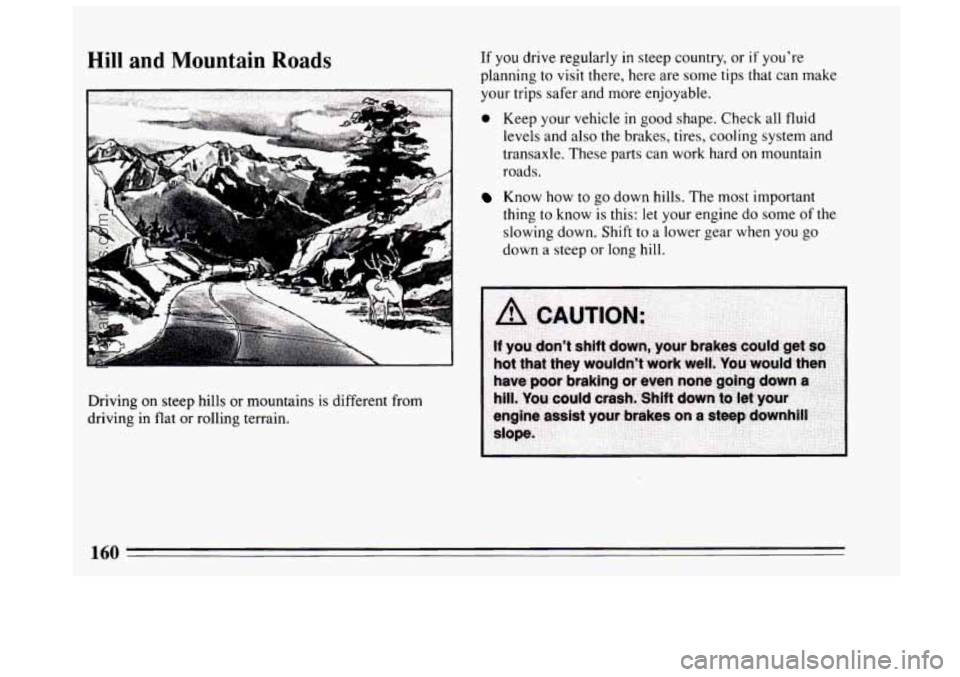
Hill and Mountain Roads
I.
. ...
Driving on steep hills or mountains is different from
driving in flat or rolling terrain. If you
drive regularly
in steep country, or if you're
planning
to visit there, here are some tips that can make
your trips safer and more enjoyable.
0 Keep your vehicle in good shape. Check all fluid
levels and also the brakes, tires, cooling system and
transaxle. These parts can work hard on mountain
roads.
Know how to go down hills. The most important
thing
to know is this: let your engine do some of the
slowing down. Shift to a lower gear when you go
down a steep or long hill.
160
ProCarManuals.com
Page 163 of 308
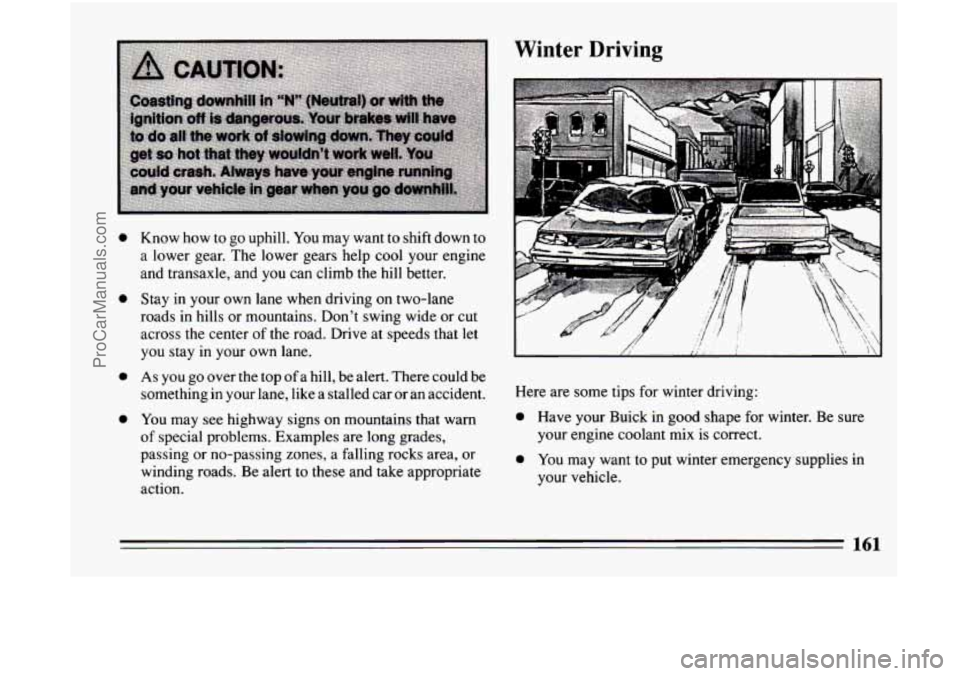
Winter Driving
0
0
0
0
Know how to go uphill. You may want to shift down to
a lower gear. The lower gears help cool your engine
and transaxle, and
you can climb the hill better.
Stay
in your own lane when driving on two-lane
roads
in hills or mountains. Don’t swing wide or cut
across the center
of the road. Drive at speeds that let
you stay
in your own lane.
As you go over the top of a hill, be alert. There could be
something in your lane, like
a stalled car or an accident.
You may see highway signs on mountains that warn
of special problems. Examples are long grades,
passing or no-passing zones,
a falling rocks area, or
winding roads. Be alert
to these and take appropriate
action. Here
are some tips for winter driving:
0 Have your Buick in good shape for winter. Be sure
0 You may want to put winter emergency supplies in
your
engine coolant mix is correct.
your vehicle.
161
ProCarManuals.com
Page 164 of 308
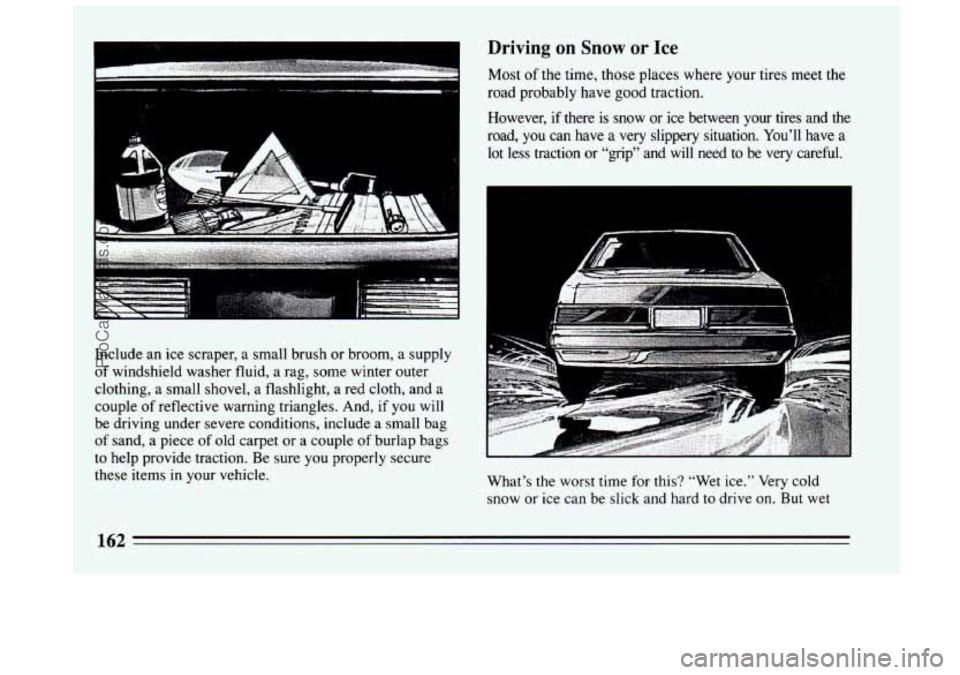
.I. L.
Include an ice scraper, a small brush or broom, a supply
of windshield washer fluid, a rag, some winter outer
clothing,
a small shovel, a flashlight, a red cloth, and a
couple
of reflective warning triangles. And, if you will
be driving under severe conditions, include a small bag
of sand, a piece of old carpet or a couple of burlap bags
to help provide traction. Be sure you properly secure
these items in your vehicle.
Driving on Snow or Ice
Most of the time, those places where your tires meet the
road probably have good traction.
However,
if there is snow or ice between your tires and the
road,
you can have a very slippery situation. You’ll have a
lot less traction or “grip” and will need to be very careful.
What’s the worst time for this? “Wet ice.” Very cold
snow or ice can be slick and hard to drive
on. But wet
162
ProCarManuals.com
Page 165 of 308
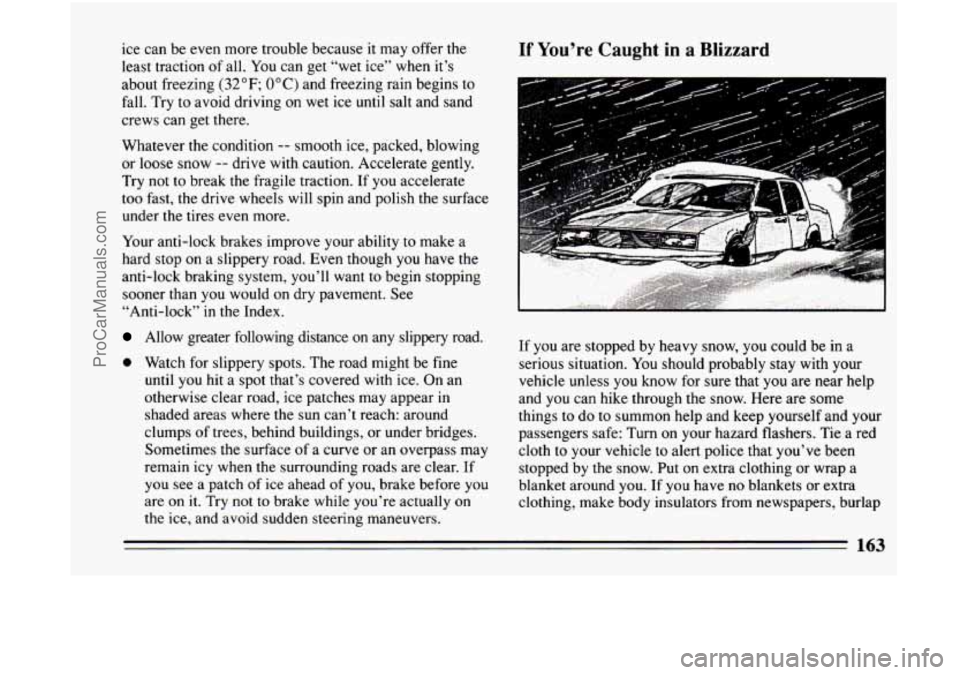
ice can be even more trouble because it may offer the
least traction
of all. You can get “wet ice’’ when it’s
about freezing
(32°F; OOC) and freezing rain begins to
fall. Try to avoid driving
on wet ice until salt and sand
crews can get there.
Whatever the condition
-- smooth ice, packed, blowing
or loose snow
-- drive with caution. Accelerate gently.
Try not to break
the fragile traction. If you accelerate
too fast, the drive wheels will spin and polish the surface
under the tires even more.
Your anti-lock brakes improve your ability to make a
hard stop on a slippery road. Even though you have the
anti-lock braking system, you’ll want to begin stopping
sooner than
you would on dry pavement. See
“Anti-lock” in
the Index.
Allow greater following distance on any slippery road.
0 Watch for slippery spots. The road might be fine
until you hit a spot that’s covered with ice. On an
otherwise clear road, ice patches may appear in
shaded areas where the sun can’t reach: around
clumps
of trees, behind buildings, or under bridges.
Sometimes the surface of a curve or an overpass may
remain icy when the surrounding roads are clear. If
you see a patch
of ice ahead of you, brake before you
are on it. Try not to brake while you’re actually on
the ice, and avoid sudden steering maneuvers.
If You’re Caught in a Blizzard
e
If you are stopped by heavy snow, you could be in a
serious situation.
You should probably stay with your
vehicle unless
you know for sure that you are near help
and you can hike through the snow. Here are some
things to do to summon help and keep yourself and your
passengers safe: Turn
on your hazard flashers. Tie a red
cloth to your vehicle to alert police that you’ve been
stopped by the snow. Put on extra clothing or wrap a
blanket around
you. If you have no blankets or extra
clothing, make body insulators from newspapers, burlap
- 163
ProCarManuals.com
Page 166 of 308
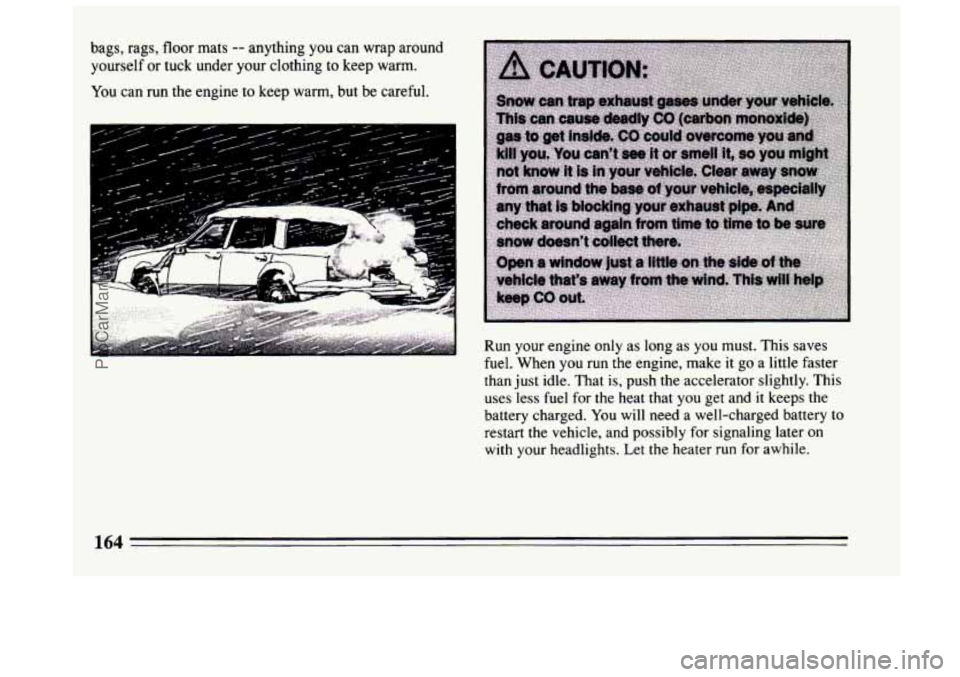
bags, rags, floor mats -- anything you can wrap around
yourself or tuck under your clothing
to keep warm.
You
can run the engine to keep warm, but be careful.
Run your engine only as long as
you must. This saves
fuel. When you run the engine, make it go a little faster
than just idle. That is, push the accelerator slightly. This
uses less fuel for the heat that you get and it keeps the
battery charged.
You will need a well-charged battery to
restart the vehicle, and possibly for signaling later
on
with your headlights. Let the heater run for awhile.
164
ProCarManuals.com
Page 167 of 308
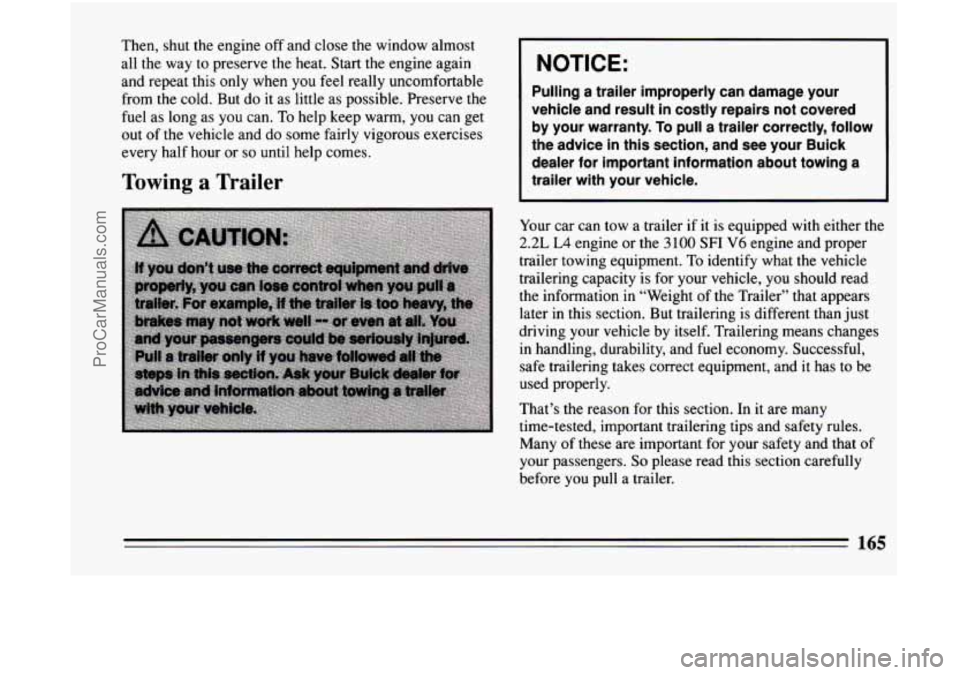
Then, shut the engine off and close the window almost
all the way to preserve the heat. Start the engine again
and repeat this only when you
feel really uncomfortable
from the cold. But do it as little as possible. Preserve the
fuel as long as
you can. To help keep warm, you can get
out
of the vehicle and do some fairly vigorous exercises
every half hour or
so until help comes.
Towing a Trailer
1 NOTICE:
Pulling a trailer improperly can damage your
vehicle and result in costly repairs not covered by your warranty.
To pull a trailer correctly, follow
the advice in this section, and see your Buick
dealer
for important information about towing a
trailer with your vehicle.
Your car can tow a trailer if it is equipped with either the
2.2L L4 engine or the 3 100 SF1 V6 engine and proper
trailer towing equipment.
To identify what the vehicle
trailering capacity
is for your vehicle, you should read
the information in “Weight
of the Trailer” that appears
later in this section. But trailering is different than just
driving your vehicle by itself. Trailering means changes
in handling, durability, and fuel economy. Successful,
safe trailering takes correct equipment, and it has
to be
used properly.
That’s the reason for this section. In
it are many
time-tested, important trailering tips and safety rules. Many of these are important for your safety and that
of
your passengers. So please read this section carefully
before
you pull a trailer.
165
ProCarManuals.com
Page 168 of 308
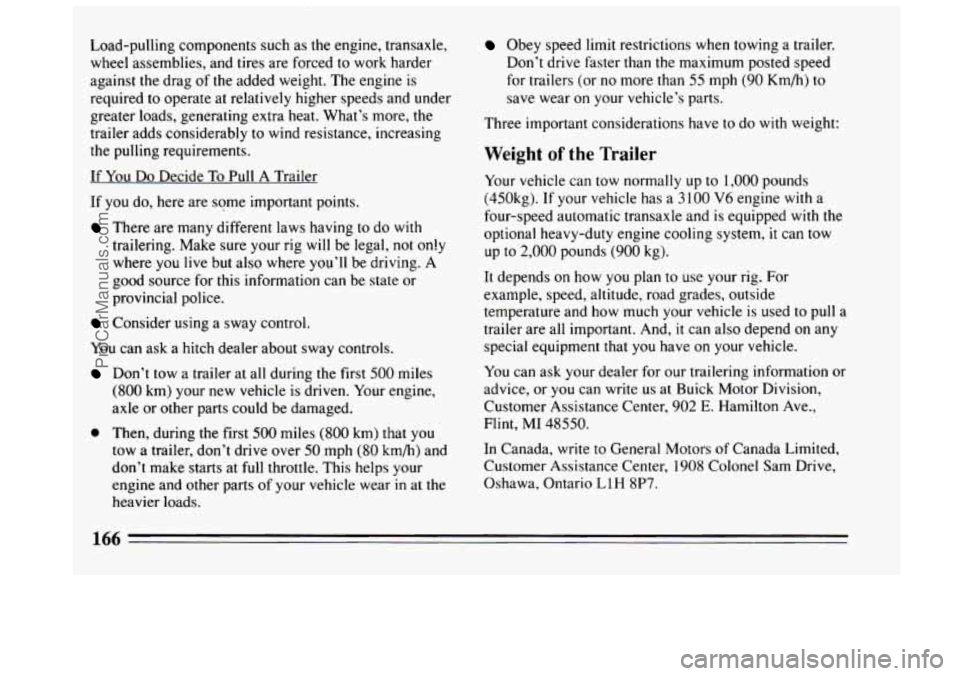
Load-pulling components such as the engine, transaxle,
wheel assemblies, and tires are forced
to work harder
against the drag of the added weight. The engine
is
required to operate at relatively higher speeds and under
greater loads, generating extra heat. What’s more, the
trailer adds considerably to wind resistance, increasing
the pulling requirements.
If
You Do Decide To Pull A Trailer
If you do, here are some important points.
There are many different laws having to do with
trailering. Make sure your rig will be legal, not on!y
where you live but also where you’ll be driving. A
good source for
this information can be state or
provincial police.
Consider using a sway control,
You can ask a hitch dealer about sway controls.
Don’t tow a trailer at all during the first 500 miles
(800 km) your new vehicle is driven. Your engine,
axle or other parts could be damaged.
0 Then, during the first 500 miles (800 km) that you
tow
a trailer, don’t drive over 50 mph (80 km/h) and
don’t make starts at full throttle. This helps your
engine and other parts
of your vehicle wear in at the
heavier loads.
Obey speed limit restrictions when towing a trailer.
Don’t drive faster than the maximum posted speed
for trailers (or no more than
55 mph (90 Km/h) to
save wear on your vehicle’s parts.
Three important considerations have to do
with weight:
Weight of the Trailer
Your vehicle can tow normally up to 1,000 pounds
(450kg). If your vehicle has a
3100 V6 engine with a
four-speed automatic transaxle and is equipped with the
optional heavy-duty engine cooling system,
it can tow
up to 2,000 pounds (900 kg).
It depends on how you plan to use your rig. For
example, speed, altitude, road grades, outside
temperature and how much your vehicle is used to pull a
trailer are all important. And,
it can also depend on any
special equipment that
you have on your vehicle.
You can ask your dealer for our trailering information or
advice, or
you can write us at Buick Motor Division,
Customer Assistance Center,
902 E. Hamilton Ave.,
Flint,
MI 48550.
In Canada, write to General Motors
of Canada Limited,
Customer Assistance Center,
1908 Colonel Sam Drive,
Oshawa, Ontario L1H
8P7.
166
ProCarManuals.com
Page 169 of 308
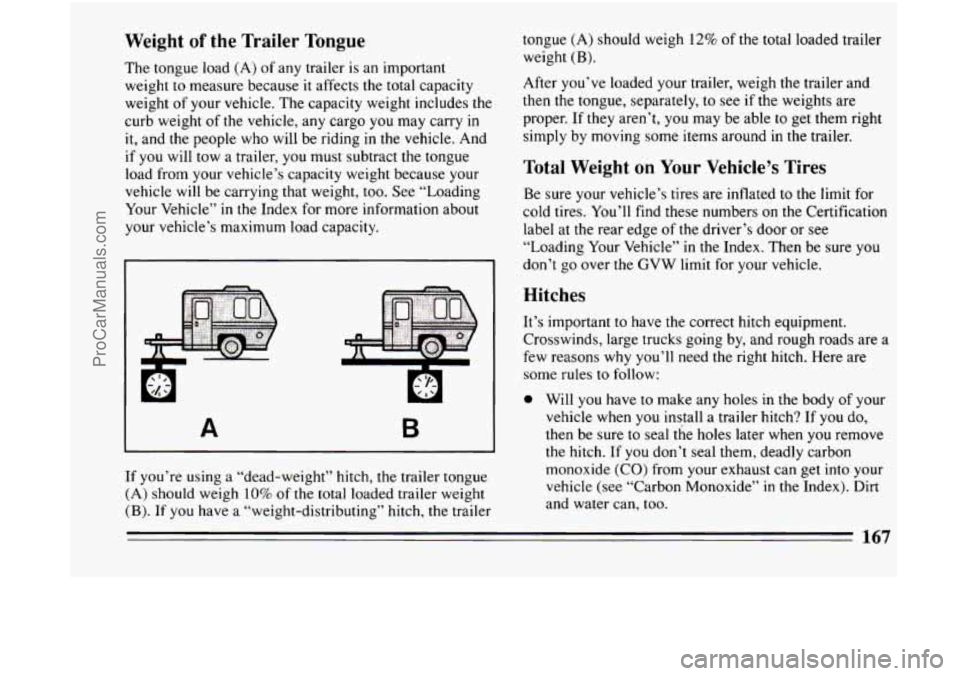
Weight of the Trailer Tongue
The tongue load (A) of any trailer is an important
weight to measure because it affects the total capacity
weight of your vehicle. The capacity weight includes the
curb weight of
the vehicle, any cargo you may carry in
it, and the people who will be riding in the vehicle. And
if you will tow a trailer, you must subtract the tongue
load from your vehicle’s capacity weight because your
vehicle will be carrying that weight, too. See “Loading
Your Vehicle”
in the Index for more information about
your vehicle’s maximum load capacity.
B I
If you’re using a “dead-weight” hitch, the trailer tongue
(A) should weigh 10% of the total loaded trailer weight
(B). If you have a “weight-distributing” hitch, the trailer tongue
(A) should weigh
12% of the total loaded trailer
weight (B).
After
you’ve loaded your trailer, weigh the trailer and
then the tongue, separately,
to see if the weights are
proper. If
they aren’t, you may be able to get them right
simply by moving some items around in
the trailer.
Total Weight on Your Vehicle’s Tires
Be sure your vehicle’s tires are inflated to the limit for
cold tires, You’ll find these numbers
on the Certification
label at
the rear edge of the driver’s door or see
“Loading Your Vehicle” in the Index. Then be sure
you
don’t go over the GVW limit for your vehicle.
Hitches
It’s important to have the correct hitch equipment.
Crosswinds, large trucks going by, and rough roads are a
few reasons why you’ll need the right hitch. Here are
some rules to follow:
0 Will you have to make any holes in the body of your
vehicle when
you install a trailer hitch? If you do,
then be sure to seal
the holes later when you remove
the hitch. If
you don’t seal them, deadly carbon
monoxide
(CO) from your exhaust can get into your
vehicle (see “Carbon Monoxide”
in the Index). Dirt
and water can,
too.
167
ProCarManuals.com
Page 170 of 308
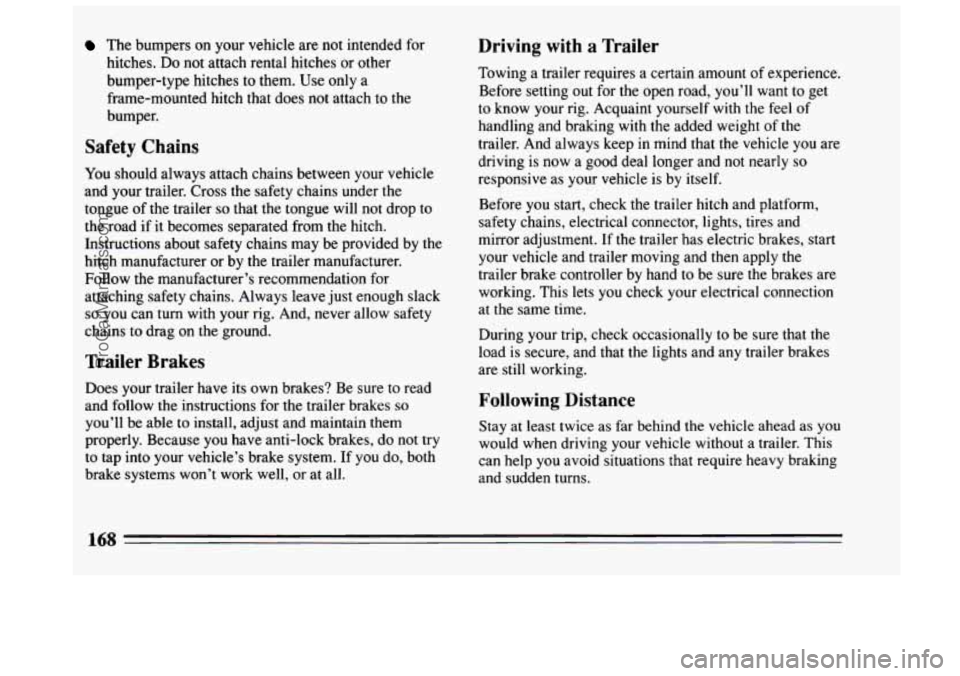
The bumpers on your vehicle are not intended for
hitches.
Do not attach rental hitches or other
bumper-type hitches to them. Use only a
frame-mounted hitch that does not attach to the
bumper.
Safety Chains
You should always attach chains between your vehicle
and your trailer. Cross the safety chains under the
tongue of the trailer
so that the tongue will not drop to
the road if it becomes separated from the hitch.
Instructions about safety chains may be provided by the
hitch manufacturer or by the trailer manufacturer.
Follow the manufacturer’s recommendation for
attaching safety chains. Always leave just enough slack
so you can turn with your rig. And, never allow safety
chains
to drag on the ground.
Trailer Brakes
Does your trailer have its own brakes? Be sure to read
and follow the instructions for the trailer brakes
so
you’ll be able to install, adjust and maintain them
properly. Because you have anti-lock brakes, do not try
to tap into your vehicle’s brake system. If you do, both
brake systems won’t work well, or at all.
Driving with a Trailer
Towing a trailer requires a certain amount of experience.
Before setting out for the open road, you’ll want to get
to know your rig. Acquaint yourself with the feel
of
handling and braking with the added weight of the
trailer. And always keep in mind that the vehicle you are
driving is now a good deal longer and not nearly
so
responsive as your vehicle is by itself.
Before
you start, check the trailer hitch and platform,
safety chains, electrical connector, lights, tires and
mirror adjustment. If the trailer has electric brakes, start
your vehicle and trailer moving and
then apply the
trailer brake controller by hand to be sure the brakes are
working. This lets
you check your electrical connection
at the same time.
During your trip, check occasionally to be sure that the
load is secure, and that the lights and any trailer brakes
are still working.
Following Distance
Stay at least twice as far behind the vehicle ahead as you
would when driving your vehicle without a trailer. This
can help
you avoid situations that require heavy braking
and sudden turns.
168
ProCarManuals.com